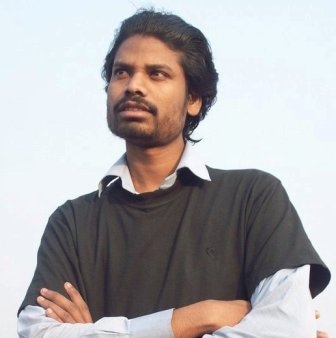Unnamati Syama Sundar
 [This graphic narrative on the Tsunduru massacre follows Syama Sundar’s earlier brilliant work on Karamchedu. Chunduru remains one of the biggest, and most vicious organized attacks on Dalits in independent India’s history. There are varied accounts of how many people were actually killed in the attack, and after the attack (due to shock and trauma, during protests etc). For instance, most official sources pin the number at eight, Duddu Prabhakar, President of the ‘Kula Nirmoolana Porata Samithi’ (‘Struggle Committee for Eradication of Caste’), says twelve people were killed. The late human rights activist K. Balagopal came up with an estimate of 19 (including nine persons who could not be traced after that day, nor were their bodies found). That tells you a lot about Chunduru, that it never really ended.
[This graphic narrative on the Tsunduru massacre follows Syama Sundar’s earlier brilliant work on Karamchedu. Chunduru remains one of the biggest, and most vicious organized attacks on Dalits in independent India’s history. There are varied accounts of how many people were actually killed in the attack, and after the attack (due to shock and trauma, during protests etc). For instance, most official sources pin the number at eight, Duddu Prabhakar, President of the ‘Kula Nirmoolana Porata Samithi’ (‘Struggle Committee for Eradication of Caste’), says twelve people were killed. The late human rights activist K. Balagopal came up with an estimate of 19 (including nine persons who could not be traced after that day, nor were their bodies found). That tells you a lot about Chunduru, that it never really ended.
Duddu Prabhakar reconstructs the Tsunduru attack:
Later, on August 6th, 1991, Chunduru (Tsunduru) happened. It doesn’t mean that there were no such incidents in the intervening period (after Karamchedu); one or two incidents did occur, but such an organized attack, such a brutal massacre happened only in 1991. On 6th August 1991, 8 Dalits — 7 Malas and one Madiga, the Malas and Madigas lived together in that village (were killed).
Chunduru is in Guntur district, a developed village, compared with other Dalit hamlets – both villages were beside the railway tracks. The Dalits worked as gangmen in the railways and as coolies in the agriculturally prosperous village. So they were able to earn a little, and managed to educate their children to whatever extent. There were jobholders in the village; there were some 8 M.A.s in the village even back then.
In everything, as you know the ways we try to assert our self-respect— wearing shoes, the way of going to college—they couldn’t tolerate that. There was a police picket in the village, there had been some conflicts happening, just as in Lakshimpeta. So on that day, the police told the Dalits that: the Reddies and Naidus (Kapus) are planning to attack you; we can’t save you (the Dalits) from them, so leave the village.
So they all ran away, but the attackers were waiting in their tractors in the fields! They had made the police tell the Dalits that they should run away, while they lay in ambush in the fields which fall on the way. There they killed them (the Dalits), and they did it in such a way – they cut them down, chopped them — separating the heads, hands, legs — stuffed those parts into gunny sacks and threw them into the Tungabhadra drain canal which runs through there and stamped them into the mud. [Continues after the images]

~~

~~

~~

~~

~~

~~

~~

~~

~~

~~

~~

~~

~
It took four days to find all those (bodies). The bodies had swollen so much and when they were taken to the Tenali government hospital, such big insects crawled onto the legs of those around. The doctor who performed the post-mortem was a Dalit. He couldn’t digest that scene, and hanged himself after going home that night. His name was Ravichandra, the doctor who did the post-mortem. He couldn’t take the brutality.
They had killed eight, but later there was this incident involving someone called Parishuddha Rao (a resident of the Malapalli). He regularly attended prayer meetings (in the church) and did nothing else; he had done his B.A, and had appeared for the B.Ed entrance exam, but was unemployed and indulged in no youthful pranks unlike others of his age. He used to talk with pride of his younger brother being employed.
When he saw his younger brother’s corpse, which had swollen so much, he suffered from a heart attack and died.
To demand the arrest of all the killers an agitation was started. A protest tent came up in Chunduru, and the agitation was organized by the Dalit Mahasabha. Yes, it was again the Dalit Mahasabha (which organized it). So when the agitation was on, a police officer called Meena, SP Meena, arrived on the scene. He alleged that there were Naxalites among the protesters, and that was dangerous, and said that the protest camp should be vacated. He ordered firing.
He ordered firing on the protest camp! On the protesters who were demanding the arrest of the killers. So in the police firing, one Anil Kumar, (a very politically conscious youth) who was also a graduate and was leading the protest– he was shot dead.
While the Chunduru Reddies directly killed 8, those killed indirectly were the doctor who committed suicide, Parishuddha Rao who died of heart attack after seeing his brother’s corpse and Anil Kumar who was leading the protest, in the hunger strike camp, and was specifically targeted by the police and shot in the heart.
The agitators had planned a ‘Chalo Delhi’ programme to press for justice. When they reached Delhi, one Dalit woman died as they were trying to cross a road. So, that brings the total death toll to twelve. The total number of those who died due to the Chunduru massacre, directly or indirectly, was twelve.]
~~~
Unnamati Syama Sundar is a Ph.D student in the School of Arts and Aesthetics, JNU. He is also an artist and photographer with keen sensibilities and a critical interest in social and political issues; his cartoons and illustrations appear in many Round Table India articles.









